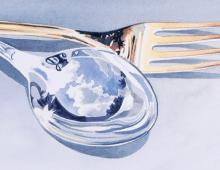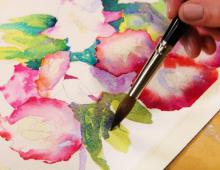Как выпрямить волосяной пучок художественной кисти
Полезные приемы в вашу копилку художественных знаний.
Если кисть кажется совсем негодной, а ее ворс торчит в разные стороны и не держит форму, помойте ее, смочите волоски олифой и придайте им нужную форму. Теперь окуните смазанную олифой кисть в водорастворимый клей (я использую клей Elmers), и оставьте ее сохнуть на пару недель (ворсом вверх!). Поскольку клей водорастворимый, вы легко смоете его теплой водой без мыла. И готово! Ваша кисть обрела вторую жизнь.
Я пришла к выводу, что таким способом можно спасти даже самых безнадежных «жертв» художественного произвола.
Совет от Джима
Если волоски кисти из свиной щетины слегка растрепались, вернуть им прежнюю форму можно, увлажнив их слабым мыльным раствором воды и завернув их в туалетную бумагу, одновременно придавая им желательный силуэт. Пусть они просохнут одну ночь. Затем, снимите туалетную бумагу. Ворс перестанет пушиться.
Совет от Рене Гирарди
Чтобы выровнять пучок кисти, используйте небольшое количество вазелина. Это действительно волшебный метод (но он больше подходит для маленьких кистей, чем для больших, ведь густой ворс тяжелее отмыть от вазелина перед применением кисти).
Совет от Джули
Туалетная бумага хорошо борется с заломленными и изогнутыми волосками. Для этого вымойте кисть теплой водой с мылом. Пока она влажная, положите ее на туалетную бумагу. Оберните бумагу в несколько слоев вокруг кончика кисти, фиксируя его как можно туже. При этом бумага должна остаться влажной и не сморщенной, вода с нее капать не должна. Поставьте кисть ворсом вверх и дайте ей посохнуть пару дней.
Правильная техника вырабатывается путем проб и ошибок. Однако она работает безотказно.
Автор: Marion Boddy-Evans
Поделиться статьей:
ЭТО ТОЖЕ ИНТЕРЕСНО:
Похожие статьи:
Художественные кисти это серьезное вложение. Если тщательно и…
Сегодня с большим удовольствием я представляю вам работу Джин…
Мне повезло встретиться с Полом Джексоном, когда он снимал свои…
Видели ли вы когда-нибудь акварельный рисунок, который выглядит…
Download Article
Download Article
Oh no! Your paintbrushes are stiff, either from dried paint or drying out after not using them for a while. Even if your brushes have hardened up, there are tons of easy ways you can soften your paintbrushes again with some common household products. We’ve put together a list of the best products and how to use them to restore your synthetic or natural brushes so they’re soft again.
-
A soak in hot vinegar breaks apart bristles to make any brush soft again. Heat up enough distilled white vinegar in a pot to coat the brush bristles. Set the brushes in a heat-safe container and pour the vinegar over the bristles. Leave your brushes to soften for 20–30 minutes. Then, scrape out any paint in the brush with a comb and just rinse the vinegar out. Rub a pea-sized amount of hair conditioner on the bristles to make them soft again.[1]
- Wrap the bristles in a plastic bag for 1 hour after applying the conditioner so it absorbs deeper. You do not have to rinse the conditioner out of the brush.[2]
- Wrap the bristles in a plastic bag for 1 hour after applying the conditioner so it absorbs deeper. You do not have to rinse the conditioner out of the brush.[2]
Advertisement
-
Dish soap effectively breaks down hardened water-based latex paint. Add a squirt of dish soap to a small bowl of hot water and mix it well until it suds up. Swish the brush in the soapy water and work the bristles apart gently with your fingers. Once you clean out all of the paint, give your brush a rinse and shake out the excess water.[3]
- Avoid using dish soap on natural-hair paintbrushes meant for oil paint since you could damage the bristles.
-
Water-based paint dissolves off the bristles with fabric softener. Add 1⁄2 cup (120 ml) of liquid fabric softener to 1 gallon (3.8 L) of warm water. Swish a brush caked with acrylic or latex paint through the solution for 10 seconds to help loosen the paint and soften hardened brush bristles. Run your fingers through the bristles to ensure they don’t have any leftover paint.[4]
- You can use laundry detergent if you don’t have any fabric softener.[5]
- You don’t need to rinse your brush after using fabric softener since it actually helps prevent paint from sticking to the bristles the next time you use it.
- Fabric softener also works to soften new or dried out brushes.
- You can use laundry detergent if you don’t have any fabric softener.[5]
Advertisement
-
Give acetone a try to make water-based paint slide off the bristles. Set your paintbrush in a plastic cup and pour acetone in to cover the bristles. Let the acetone soak into the bristles overnight so it can soften the hardened paint. After that, run a comb through the bristles to get any paint residue out and make the bristles flexible again.[6]
- In a pinch, you can also use nail polish remover since it normally contains acetone.
- If there’s still some stubborn pain in the bristles, try soaking your brush in acetone overnight again.
-
Rubbing alcohol can break down stubborn water-based paints. Fill a cup or bowl with enough rubbing alcohol to completely submerge the brush bristles. Set your brushes in the rubbing alcohol for a few minutes until the paint colors start to run and the bristles feel less stiff. Use a dry cloth to clean off any paint that’s still stuck in the brushes so they feel soft again.[7]
- If the bristles feel dried out after using rubbing alcohol, rub some soapy water on them when you finish cleaning.
Advertisement
-
Baby oil works best for cleaning and softening brushes caked with oil paint. Dab the brush bristles in baby oil so they’re completely coated. Gently work the oil deep into the bristles with your fingers or a clean cloth to soften the paintbrush. Push any paint residue down to the tips of the bristles so it falls off. When you finish, give your brushes a quick rinse with soapy water.[8]
- You can instead use coconut oil or linseed oil made for cleaning paintbrushes.
-
Rely on paint thinner if other natural cleaners aren’t working. Since mineral spirits and paint thinner are chemical cleaners, use them as a last resort. Pour the spirits or thinner into a clean bucket and set the brush bristles in it to soak for 20–30 minutes. After that, work the bristles with a soft brush to remove the excess paint. Then, just rinse the brush with clean water and let it dry.[9]
[10]
- You can use mineral spirits or paint thinner to clean acrylic brushes or oil brushes.
- Paint thinner can irritate your skin, and it produces harmful fumes. Work in a well-ventilated area and wear a respirator and rubber gloves when you work with it so you stay safe.[11]
- Paint thinners can damage brushes and make the bristles fall out after repeated uses.
Advertisement
-
A brush comb removes hardened paint or breaks apart stiff bristles. A brush comb has long metal tines that clean out residue and straighten the bristles. Poke the tines into the bristles where they connect to the handle and slowly pull the comb towards the end of the brush. Work through all of the bristles until you clean out all of the paint.[12]
- Just make sure that you don’t pull the comb too forcefully since it could loosen the bristles and make them fall out.[13]
- Just make sure that you don’t pull the comb too forcefully since it could loosen the bristles and make them fall out.[13]
Add New Question
-
Question
How do you soften a dry brush?
Patrick Coye is the owner and operator of Patrick’s Painting & Home Improvement in Alexandria, Virginia. With over 15 years of experience in residential construction, Patrick specializes in painting, wallpaper removal/installation, drywall, staining decks and fences, and kitchen cabinetry painting. To date, Patrick and his team have painted over 2,000 houses and stained over 800 decks. Patrick’s Company won a «Top Job» award from the American Painting contractor magazine in 2020.
Painting Specialist
Expert Answer
To try to get as much paint off of the dry brush as possible, put it in some water or Mineral Spirits paint thinner. Then, clean the brushes with laundry detergent to help soften the bristles.
-
Question
How do you clean a hardened paint brush?
Patrick Coye is the owner and operator of Patrick’s Painting & Home Improvement in Alexandria, Virginia. With over 15 years of experience in residential construction, Patrick specializes in painting, wallpaper removal/installation, drywall, staining decks and fences, and kitchen cabinetry painting. To date, Patrick and his team have painted over 2,000 houses and stained over 800 decks. Patrick’s Company won a «Top Job» award from the American Painting contractor magazine in 2020.
Painting Specialist
Expert Answer
Soak the paint brush in mineral spirits to think the paint. Then, remove as much of the paint as possible. However, be careful that you don’t handle the bristles too roughly, as they can get damaged.
-
Question
Were the hair conditioner and fabric softener tips for oil based paint brushes?
Sometimes if you soak them in hot water for a couple of minutes, it helps. If these are oil brushes though, you can’t use them right away. Don’t soak them for too long as it’s bad for your brushes!
See more answers
Ask a Question
200 characters left
Include your email address to get a message when this question is answered.
Submit
Advertisement
-
Avoid pushing the bristles down too hard since they could bend or get damaged.[14]
Show More Tips
Advertisement
References
About This Article
Article SummaryX
If your paintbrushes are hard because you haven’t used them in a while, you can use various household items to soften them up. Try applying a pea-sized amount of baby lotion or hand lotion to the bristles. Then, bend the brush back and forth on your hand so the bristles get coated in lotion up to the handle. After about 2 minutes, wipe off any excess lotion with a towel. Alternatively, soften your brushes with white vinegar. All you need to do is boil 2 to 3 cups of white vinegar and put your brush in a jar with the bristles pointing down. Once the vinegar begins to bubble, pour enough into the jar to cover the bristles and leave your brush to soak for 20 minutes. Scrape off any leftover paint with a comb, then rinse your brush under warm water. For tips on how to soften your brush using liquid fabric softener, keep reading!
Did this summary help you?
Thanks to all authors for creating a page that has been read 202,876 times.
Reader Success Stories
-
Maura Sedgeman
Dec 15, 2022
«Thank you so much! The rubbing alcohol worked perfectly on my favorite stubby bristle brush. You saved the day!»
If you buy through links on our site, we may earn a commission.
Did this article help you?
Download Article
Download Article
Oh no! Your paintbrushes are stiff, either from dried paint or drying out after not using them for a while. Even if your brushes have hardened up, there are tons of easy ways you can soften your paintbrushes again with some common household products. We’ve put together a list of the best products and how to use them to restore your synthetic or natural brushes so they’re soft again.
-
A soak in hot vinegar breaks apart bristles to make any brush soft again. Heat up enough distilled white vinegar in a pot to coat the brush bristles. Set the brushes in a heat-safe container and pour the vinegar over the bristles. Leave your brushes to soften for 20–30 minutes. Then, scrape out any paint in the brush with a comb and just rinse the vinegar out. Rub a pea-sized amount of hair conditioner on the bristles to make them soft again.[1]
- Wrap the bristles in a plastic bag for 1 hour after applying the conditioner so it absorbs deeper. You do not have to rinse the conditioner out of the brush.[2]
- Wrap the bristles in a plastic bag for 1 hour after applying the conditioner so it absorbs deeper. You do not have to rinse the conditioner out of the brush.[2]
Advertisement
-
Dish soap effectively breaks down hardened water-based latex paint. Add a squirt of dish soap to a small bowl of hot water and mix it well until it suds up. Swish the brush in the soapy water and work the bristles apart gently with your fingers. Once you clean out all of the paint, give your brush a rinse and shake out the excess water.[3]
- Avoid using dish soap on natural-hair paintbrushes meant for oil paint since you could damage the bristles.
-
Water-based paint dissolves off the bristles with fabric softener. Add 1⁄2 cup (120 ml) of liquid fabric softener to 1 gallon (3.8 L) of warm water. Swish a brush caked with acrylic or latex paint through the solution for 10 seconds to help loosen the paint and soften hardened brush bristles. Run your fingers through the bristles to ensure they don’t have any leftover paint.[4]
- You can use laundry detergent if you don’t have any fabric softener.[5]
- You don’t need to rinse your brush after using fabric softener since it actually helps prevent paint from sticking to the bristles the next time you use it.
- Fabric softener also works to soften new or dried out brushes.
- You can use laundry detergent if you don’t have any fabric softener.[5]
Advertisement
-
Give acetone a try to make water-based paint slide off the bristles. Set your paintbrush in a plastic cup and pour acetone in to cover the bristles. Let the acetone soak into the bristles overnight so it can soften the hardened paint. After that, run a comb through the bristles to get any paint residue out and make the bristles flexible again.[6]
- In a pinch, you can also use nail polish remover since it normally contains acetone.
- If there’s still some stubborn pain in the bristles, try soaking your brush in acetone overnight again.
-
Rubbing alcohol can break down stubborn water-based paints. Fill a cup or bowl with enough rubbing alcohol to completely submerge the brush bristles. Set your brushes in the rubbing alcohol for a few minutes until the paint colors start to run and the bristles feel less stiff. Use a dry cloth to clean off any paint that’s still stuck in the brushes so they feel soft again.[7]
- If the bristles feel dried out after using rubbing alcohol, rub some soapy water on them when you finish cleaning.
Advertisement
-
Baby oil works best for cleaning and softening brushes caked with oil paint. Dab the brush bristles in baby oil so they’re completely coated. Gently work the oil deep into the bristles with your fingers or a clean cloth to soften the paintbrush. Push any paint residue down to the tips of the bristles so it falls off. When you finish, give your brushes a quick rinse with soapy water.[8]
- You can instead use coconut oil or linseed oil made for cleaning paintbrushes.
-
Rely on paint thinner if other natural cleaners aren’t working. Since mineral spirits and paint thinner are chemical cleaners, use them as a last resort. Pour the spirits or thinner into a clean bucket and set the brush bristles in it to soak for 20–30 minutes. After that, work the bristles with a soft brush to remove the excess paint. Then, just rinse the brush with clean water and let it dry.[9]
[10]
- You can use mineral spirits or paint thinner to clean acrylic brushes or oil brushes.
- Paint thinner can irritate your skin, and it produces harmful fumes. Work in a well-ventilated area and wear a respirator and rubber gloves when you work with it so you stay safe.[11]
- Paint thinners can damage brushes and make the bristles fall out after repeated uses.
Advertisement
-
A brush comb removes hardened paint or breaks apart stiff bristles. A brush comb has long metal tines that clean out residue and straighten the bristles. Poke the tines into the bristles where they connect to the handle and slowly pull the comb towards the end of the brush. Work through all of the bristles until you clean out all of the paint.[12]
- Just make sure that you don’t pull the comb too forcefully since it could loosen the bristles and make them fall out.[13]
- Just make sure that you don’t pull the comb too forcefully since it could loosen the bristles and make them fall out.[13]
Add New Question
-
Question
How do you soften a dry brush?
Patrick Coye is the owner and operator of Patrick’s Painting & Home Improvement in Alexandria, Virginia. With over 15 years of experience in residential construction, Patrick specializes in painting, wallpaper removal/installation, drywall, staining decks and fences, and kitchen cabinetry painting. To date, Patrick and his team have painted over 2,000 houses and stained over 800 decks. Patrick’s Company won a «Top Job» award from the American Painting contractor magazine in 2020.
Painting Specialist
Expert Answer
To try to get as much paint off of the dry brush as possible, put it in some water or Mineral Spirits paint thinner. Then, clean the brushes with laundry detergent to help soften the bristles.
-
Question
How do you clean a hardened paint brush?
Patrick Coye is the owner and operator of Patrick’s Painting & Home Improvement in Alexandria, Virginia. With over 15 years of experience in residential construction, Patrick specializes in painting, wallpaper removal/installation, drywall, staining decks and fences, and kitchen cabinetry painting. To date, Patrick and his team have painted over 2,000 houses and stained over 800 decks. Patrick’s Company won a «Top Job» award from the American Painting contractor magazine in 2020.
Painting Specialist
Expert Answer
Soak the paint brush in mineral spirits to think the paint. Then, remove as much of the paint as possible. However, be careful that you don’t handle the bristles too roughly, as they can get damaged.
-
Question
Were the hair conditioner and fabric softener tips for oil based paint brushes?
Sometimes if you soak them in hot water for a couple of minutes, it helps. If these are oil brushes though, you can’t use them right away. Don’t soak them for too long as it’s bad for your brushes!
See more answers
Ask a Question
200 characters left
Include your email address to get a message when this question is answered.
Submit
Advertisement
-
Avoid pushing the bristles down too hard since they could bend or get damaged.[14]
Show More Tips
Advertisement
References
About This Article
Article SummaryX
If your paintbrushes are hard because you haven’t used them in a while, you can use various household items to soften them up. Try applying a pea-sized amount of baby lotion or hand lotion to the bristles. Then, bend the brush back and forth on your hand so the bristles get coated in lotion up to the handle. After about 2 minutes, wipe off any excess lotion with a towel. Alternatively, soften your brushes with white vinegar. All you need to do is boil 2 to 3 cups of white vinegar and put your brush in a jar with the bristles pointing down. Once the vinegar begins to bubble, pour enough into the jar to cover the bristles and leave your brush to soak for 20 minutes. Scrape off any leftover paint with a comb, then rinse your brush under warm water. For tips on how to soften your brush using liquid fabric softener, keep reading!
Did this summary help you?
Thanks to all authors for creating a page that has been read 202,876 times.
Reader Success Stories
-
Maura Sedgeman
Dec 15, 2022
«Thank you so much! The rubbing alcohol worked perfectly on my favorite stubby bristle brush. You saved the day!»
If you buy through links on our site, we may earn a commission.









